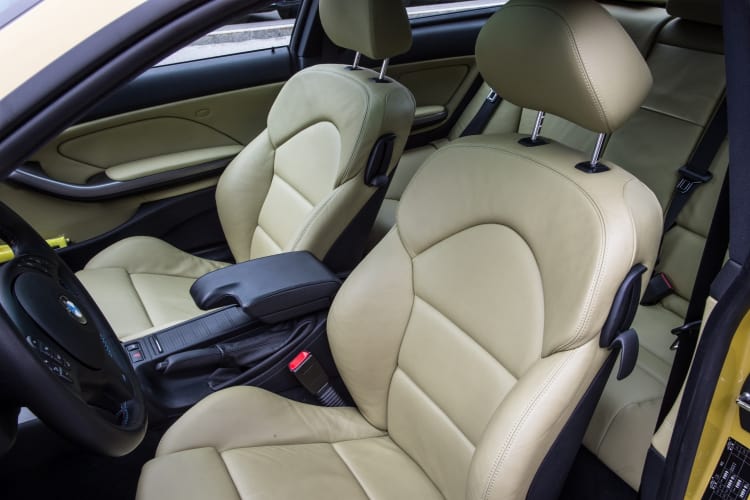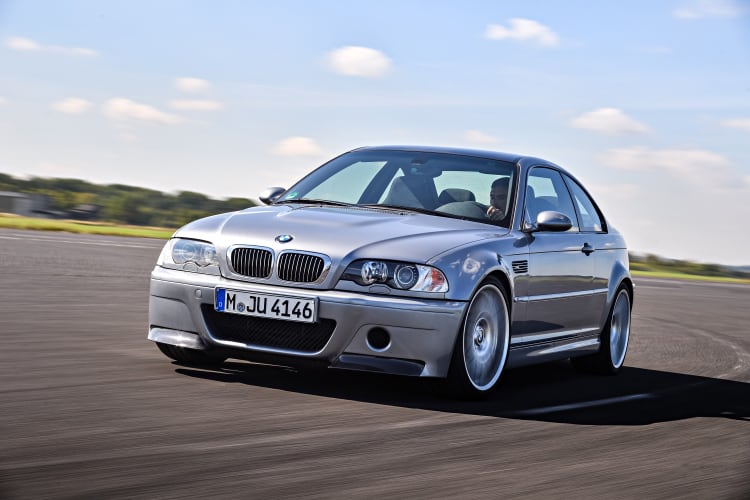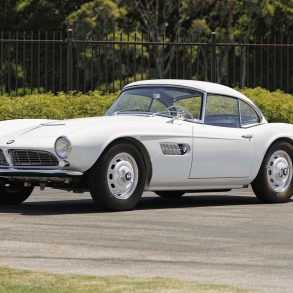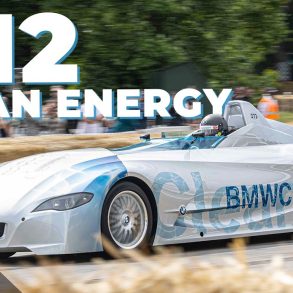Welcome to our Buyer’s Guide for the BMW E46 M3. This guide will be a comprehensive guide including background, production numbers, models, and more. Most importantly, we provide 10 things you should know about the BMW E46 M3 before you buy one.
For the last 35 years, car enthusiasts have lusted after BMW M3 models. Throughout the six generations, BMW grew this model from obscure homologation special to sports car legend of the highest order. Successful on the streets and the tracks, each of M3’s generations has its own distinctive character, making the discussion on which is the best or the purest endlessly fascinating.
The BMW E46 M3, produced from 2000 to 2006, is arguably the closest to the ideal of what the M3 should be and amongst one of the best driver’s cars.
Background: How The E46 M3 Came About
The first M3 (E30 generation) was introduced in 1986, followed by the second (E36), which was presented in 1992.
The E30 was a racing car in disguise, a homologation special built by BMW so its M Performance division could race.

Its enormous success on the track and amongst the performance car buyers showed the company that there was significant potential. So, BMW made M3 into a much more mature, faster, and comfortable model when the second generation arrived. Purists protested that the E36 M3 wasn’t that much different from the standard model.
For the successor, the E46 M3, the company decided to go all out and create it almost from scratch with a host of individual parts and components.
When the E46 M3 was introduced in late 2000, the car industry was stunned. It was a proper M car with elegant yet aggressive styling, high-revving and mighty (for the standards of the day) engine. The engine was matched with an engaging six-speed manual and innovative SMG II automated manual transmissions, producing sublime handling.
The first tests revealed that the car drove as great as it looked and that BMW hit the home run with this version of their best-selling E46 3-Series platform.

The heart of any M car was the engine, and in the case of E46 M3, it was the S54, 3.2-liter, a straight-six unit with 343 hp and 8,000 rpm redline. With an alloy block and head and electronically-controlled throttle bodies, it also delivered 269 lb-ft of torque and 0 to 60 mph times of just over 5 seconds. Even today, those are respectable figures, but in 2000, it was close to base Porsche 911 numbers.
The E46 was offered in two distinct variants – coupe and convertible, but the sedan version, like the E36 M3, was ruled out by BMW. During the six years of production, BMW made exactly 85,766 cars, making the E46 M3 best-selling M3 up to date.
Buying a BMW E46 M3
Before we dive into specifics, we need to shed light on the models and versions BMW produced over the years. There aren’t many different-spec cars, but there is a big difference in the desirability of vehicles available, which will reflect the asking price.
How many BMW E46 M3 were produced?
BMW produced 85,766 E46 M3 vehicles. Out of 85,766 cars produced, around 56,000 were coupes, and 30,000 were convertibles.
Along with the standard E46 M3, BMW produced the following unique versions:
BMW E46 M3 CSL
Produced in just 1,383 examples, the BMW M3 CSL (Coupe Sport Licht) was offered only in Europe and few selected markets.

This model was only produced as a coupe with a carbon-fiber roof, unique front bumper, and trunk lid and in two special colors, silver and gray.
The CSL was a more exclusive model with emphasis on less weight (110 kgs lighter than the standard car), more power (17 hp more), and better driving dynamics due to revised suspension and braking. The CSL had slightly better performance and was produced exclusively with the SMG II transmission.
BMW E46 M3 Competition Package/CS
Offered only in 2005, the CS model was a cross between the standard car and the rare M3 CSL. It resembled a regular M3 from the outside, but it had larger disc brakes, CSL-style 19-inch rims, revised steering, driving modes, and a CSL steering wheel. However, the gearbox options, being a six-speed conventional manual transmission and the SMG transmission were unchanged.

BMW E46 M3 GTR
The GTR was a homologation special with just 10 street-legal examples produced.
Powered by a 4-liter V8 engine with 380 hp and significantly different bodywork, this is the rarest and almost mythical E46 M3 (price tag was approximately $218,00 when it went on sale.
Inspecting an E46 M3 For Purchase
Although the E46 M3 was a well-designed and well-built car, most examples are now approaching the 20-year mark, which means they are starting to develop various problems. Most of them are solvable, but you should thoroughly check the car before you buy since sometimes potential issues are not easily noticeable.
Here are 10 things to check before buying a BMW E46 M3:
1. Engine
The S54 is a reasonably dependable unit; however, high mileage examples can develop numerous problems with the solenoids, throttle bodies, and Vanos system due to its high-revving nature.

Like failing gaskets and seals and valve adjustments, most of those problems are based on irregular maintenance, so finding the example with complete service history is a must.
Some S54 motors will eventually have difficulties with piston rings which will lead to extensive fuel consumption. If you want to avoid expensive trips to the dealer, finding an example with less than 100,000 miles would be sound advice.
2. Water Pump
The E46 series cars are known for their cooling issues, including failing water pumps.
As a rule of thumb, you may need to replace the S54 water pump every 100,000 miles. That being said, failures can occur as shortly as 60,000 miles.
Symptoms suggestive of a water pump failure includes overheating, coolant leaks, the cooling fan running at full speed and the car in ‘limp mode.’
3. S54 VANOS Issues
VANOS, is the variable valve timing system the M3 E46 employs to adjust cam and valve timing across the RPM range.
When you test drive your future E46 M3, pay attention to the following symptoms: lack of power at lower rpm, hesitant acceleration, rough idle, and long cranking of the cold engine. All of that could be a sign of Vanos problems.
There are many different parts within the VANOS system that frequently fail, including:
- VANOS Oil Pump
- VANOS Solenoid
- Camshaft Sprocket Bolts
- Exhaust Camshaft Hub
The replacement costs vary depending on the cause however if you need to replace the entire unit with a rebuilt unit it may cost around $1800.
4. Sequential Manual Gearbox
The automated manual, which used electro-hydraulically acetated clutch and shift paddles, was a very advanced concept for the early 2000s, and the Sequential Manual Gearbox (SMG) proved popular with the buyers. However, it was also criticized for its lack of refinement at lower RPMs and glitchy software.
The SMG cars are generally cheaper since the buyers opt for a 6-speed manual transmission for a more engaging driving feel and dynamics.
The most common problem with the SMG will be that of skip shift and replacement of the gearbox will set you back around $7,000,
Similar to the engine, SMG II needs regular servicing and oil changes. If you find one with trouble shifting, jerks at lower speeds, and overheats, it is highly likely that the SMG pump, which is a separate unit from mechanical components, is on its way out.
5. Subframe Cracks
The E46 M3’s most common problem is also one of the scariest, and it is the subframe cracks. The subframe is mounted employing four points of contact underneath the car between the rear wheels. The most typical initial sign of failure within the rear axle carrier panel structure is cracking developing at the rear subframe mounts.
The cracks appear even on cars driven solely on the street and have never been on track or drag strip, and all variants.
To inspect the prospective purchase, you need to put the car on the lift and use a flashlight to see if there are any cracks near the four subframe mounts. Despite being able to fix the problem, it is quite an expensive repair and not one to inherit.
6. Interior
When inspecting the interior of the E46 M3, pay attention to the condition of the unique items. M3 has a different seat, instrument cluster, and rearview mirror for those who don’t know, all of which are hard to find and expensive.

The seats should be in good condition with no rips and tears. Leather is most common, but cloth interior can also be found.
High mileage cars can have a problem with the headliner, especially the examples which spent their lives in a warm climate.
Turn the vehicle on and inspect the dashboard to endure no information warning lights are on. While the car is running its a good time to inspect the heater and air conditioning.
The electricals should also be running smoothly, including power windows, electric seat operations, heated seats and moon roof functions.
7. Bodywork
It is essential to understand that E46 M3 has 80% unique body parts compared to the standard E46 Coupe/Convertible model. Even the gas cap cover is different.

When inspecting the bodywork, you want to see that the panel lines are even and tight, with no discoloration or rust. The E46 M3 will develop rust only if it is poorly repaired after an accident, and you should stay away from such cars. Also, check the rear wheel arches, trunk, and rocker panels for any signs of repair and rust.
8. Rod Bearing Issues
The connecting rod bearings installed in the E46 M3 cars made from 2001 to 2003 were vulnerable to overheating and subsequent premature failure leading to total engine failure.
If looking at a car of these years, confirm that the vehicle had the connecting rods replaced.
9. Clutch
Every true car enthusiast will initially go for manual-equipped BMW E46 M3, which is entirely understandable. The 6-speed Getrag gearbox is perfect with ideal and well-designed gears providing the perfect driving experience. However, the clutch replacement is expensive, and most owners avoided doing so.
When you test drive the car, the clutch should feel smooth, progressive and it shouldn’t have absolutely any slipping, not from the start, not at speed. If the clutch pedal is hard and the car engages when you are almost released, it is a clear sign that this M3 needs a replacement kit.
10. Suspension, Tires, and Brakes
The BMW E46 M3 has an aluminum suspension for more precise roadholding and weight savings which is expensive to replace if damaged.
One of the best ways to see if the car has damaged suspension or just needs an alignment is to inspect the tires. They should be equally worn and the same size (18 standard and 19-inch optional).

The car should track and stop straight, and any pulling aside is a sign of a potential problem. Be sure to find an example with recently done brakes and pads since it could be costly to replace, especially in CSL or CS-equipped models.
Buying a BMW E46 M3 will deliver a highly enjoyable sports car with the unmistakable sound of the S54 engine. Follow the points above to avoid major pitfalls when buying the vehicle. In addition, always try to buy a car with sound, full-service history, and confirmation that it has been cherished and garaged. Happy BMW hunting!
[Images courtesy of BMW]










